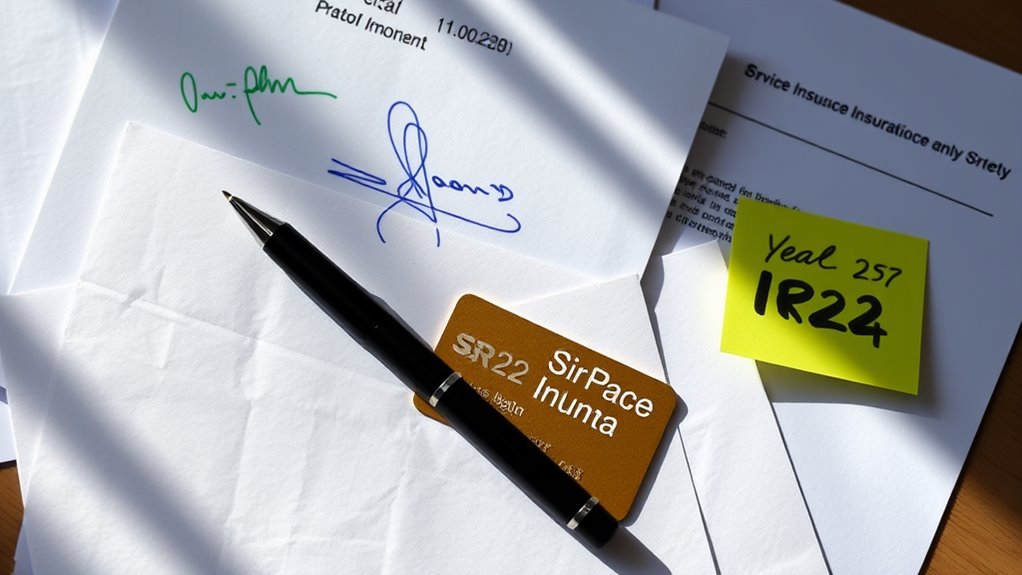Imagine standing at a crossroads, where the path to renewing your SR-22 hinges on a few essential documents. You'll need your current driver's license or ID, proof of residence, and specific insurance details. Additionally, don't forget any court documents and the filing fee. Each piece plays a significant role in ensuring a smooth renewal. But how do you gather these essentials efficiently and avoid common pitfalls?
[Maneuvering the SR-22 renewal process can seem overwhelming, but understanding the important documents you'll need simplifies the task. First and foremost, it's imperative to remember that an SR-22 isn't an insurance policy; instead, it serves as a declaration of financial responsibility for high-risk drivers. States typically require it for drivers with DUIs or multiple traffic offenses, and it can last anywhere from one to three years, depending on your specific situation. Failing to maintain an SR-22 can lead to serious consequences, including license suspension. As a result, having the right documentation ready for your renewal is essential.]
[To start the process, you'll need to present valid identification. Your primary document should be a current driver's license. If you don't have one, a state ID or passport can serve as an alternative. Some states may also request your Social Security Number for verification purposes. Fortunately, you won't need to submit additional personal documents beyond those used for identification, making this first step relatively straightforward. Understanding the SR-22 insurance requirement is crucial to ensure compliance during the renewal process.]
[Next, you'll need to prove your residence, which is important for the insurance underwriting process. Acceptable documents include utility bills—like electricity or water—with your name and address, bank statements that show your residential address, or lease agreements if you're renting your home. These documents guarantee that your insurance provider has the correct address for correspondence, which is crucial for maintaining your SR-22 status.]
[Equally important are the details of your current insurance policy. You'll need to provide your insurance policy number and its effective date, along with the insurance provider's name and contact information. It's necessary to show proof of continuous coverage, as the SR-22 form must be attached to an active insurance policy for renewal. In most cases, you won't need to provide case numbers unless your state specifies otherwise. Additionally, it's essential to remember that the SR-22 requirement must be fulfilled to avoid any legal implications.]
[Don't forget about the fees associated with the renewal process. Typically, there's a one-time SR-22 filing fee that ranges from $15 to $50, along with annual or monthly insurance premiums that must be paid in advance. Fees can vary greatly based on your insurance provider and state regulations. Be mindful that late renewals could incur additional charges or penalties, so it's best to act promptly.]
[If your situation involves any court-related documents, you'll need to include those as well. This could mean submitting court sentencing documents for any convictions that necessitate an SR-22, along with proof that you've fulfilled any legal obligations, such as completing DUI programs. Failure to provide these documents could delay your renewal, so make sure you comply with all court orders.]
[Finally, the filing process requires your insurance company to electronically file the SR-22 form and confirm that it's on record with the DMV. Continuous proof of insurance coverage is mandatory, and any lapse in coverage requires an SR-26 filing to notify the DMV. By handling these steps diligently and confirming all documentation is in order, you can navigate the SR-22 renewal process smoothly and avoid potential pitfalls.
Conclusion
Renewing your SR-22 may seem intimidating, but gathering the right documents is like assembling a puzzle—each piece is essential for the bigger picture. Imagine traversing a maze; without the proper documents, you risk getting lost. Just as a map guides you through twists and turns, having your driver's license, proof of residence, and insurance details at hand will lead you to a smoother renewal process. Stay organized, and you'll find your way out with ease.

